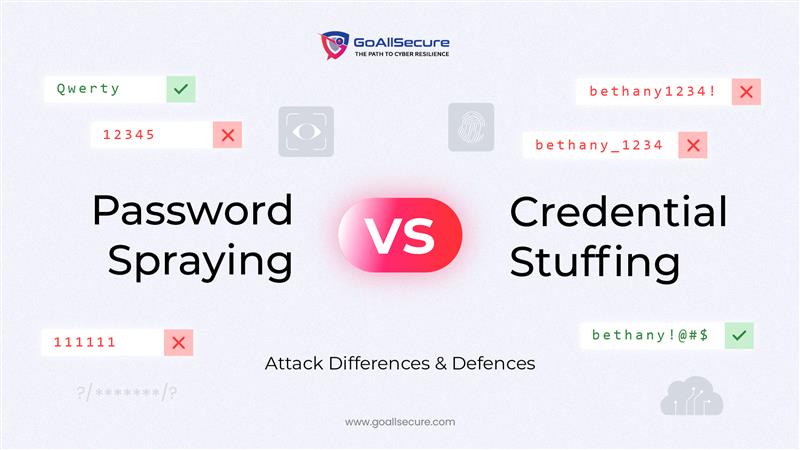You are susceptible to losing your passwords if you reuse them.
We are sure you have heard this a million times, and rightfully so. Password spraying is one of the two most popular methods for compromising digital accounts, the other one being credential stuffing. These two attack strategies have become recurring and very powerful threats in the escalating fight between cybercriminals and cybersecurity experts. Although they are usually discussed together—and both seek to compromise user accounts—they are essentially different in method, scale, and mitigating techniques. This blog will examine the workings of these attacks, highlight their distinctions, and outline countermeasures that companies can take to mitigate their potential risks.
What Is Password Spraying?
Every business and user of the internet employs passwords to secure their accounts. You are also asked to choose a password when you want to create almost any online account. Theoretically, this password should keep hackers out of the account. But with poor password hygiene and negligence, emerges the strategic twist on a brute-force attack called password spraying. In password spraying attacks, malicious threat actors try a limited number of often-used or default passwords, such as “123456,” “Welcome@123,” or “Password1”, across a broad spectrum of user accounts. The idea is to target a great many users instead of focusing on one account because several password attempts on a single account can set off account lockouts. Limiting login attempts per user helps avoid many automated lockout protections and alert systems.
In settings with poor password hygiene, particularly those including dormant, legacy, or test accounts with weak credentials, this approach is dangerously effective. One successful effort might give attackers access to important systems, including internal portals, VPNs, or business email.
What Is Credential Stuffing?
Credential stuffing works differently from password spraying. Getting access (of course, illegal access) to user logins and passwords is the first step in credential stuffing. Phishing emails are a popular method for accomplishing this. Employees receive phoney emails from malicious actors requesting that they update or modify their usernames and passwords. Users are directed to a spoof website that logs their login information and uses it to compromise accounts when they click on the provided link.
In short, attackers use actual, once-hacked username-password combinations instead of guessing. Leaked through past data breaches, these credentials—based on the general habit of password reuse—are injected into automated scripts or botnets and tested across a broad spectrum of services.
Credential stuffing depends on scale and automation; it does not call for experimentation. Attackers can try millions of logins in hours using billions of leaked credentials that are floating on the dark web, so they leverage human tendencies and a lack of password uniqueness. Once an attacker has breached your account, they can access anything that you can access, including financial data, corporate contact lists, and privileged information.
Key Differences Between Password Spraying and Credential Stuffing
Though they are classified as account takeover (ATO) techniques, password spraying and credential stuffing differ in intent, approach, and required defences:
Password Spraying: Starting with a few passwords, password spraying is applied generally over many usernames. Emphasises breadth and avoids low- and slow-moving methods of detection.
Credential Stuffing: Beginning with known username-password combinations, credential stuffing distributes them across systems based on password reuse.
The following table attempts to bring forth the differences between the two attacks:
| Aspect | Password Spraying | Credential Stuffing |
| Definition | A brute-force attack technique that uses common passwords against multiple usernames to avoid account lockouts. | An automated attack method leveraging previously compromised username-password combinations from data breaches to access accounts. |
| Methodology | Employs widely-used passwords (like “password123”) against numerous user accounts, rotating through credentials slowly to evade detection. | Utilises bot networks to systematically test millions of leaked credential pairs across different websites and services. |
| Target | Focuses on broad user populations within specific organisations or platforms using predictable password patterns. | Exploits users who reuse the same login credentials across multiple online services and platforms. |
| Success Rate | Effectiveness relies on users choosing weak, commonly-used passwords and inadequate account lockout policies. | Higher probability of success due to widespread password reuse habits and the use of verified credential combinations. |
| Risk | Can compromise organisational security, leading to data exposure, system infiltration, and potential lateral movement within networks. | Results in widespread account compromises, financial fraud, privacy violations, and cascading security breaches across platforms. |
| Prevention Measures | Deploy account lockout mechanisms, enforce complex password policies, implement behavioural analytics, and mandate regular security awareness training. | Establish login throttling controls, deploy anomaly detection systems, promote unique passwords per service, and enable multi-factor authentication. |
These differences matter since reducing one attack does not necessarily help to reduce the other. Customised defences are absolutely essential when dealing with such attacks.
The Psychological Mechanisms Behind Password Spraying and Credential Stuffing
Both password spraying and credential stuffing employ a quick-fire method to enter systems and obtain access. The repetitive usage of passwords across several accounts is what aids the attacker in succeeding in credential stuffing. The impetus for success in password spraying is the user’s propensity to choose short, simple passwords that are easy to figure out. The main distinction is the information available to the malicious threat actors.
Despite the differences in technique, weak password security is the common source of both password spraying and credential stuffing. The outcome of inadequate password security is losing your account and much more. Both attack forms make use of the following user actions:
- Simple and convenience-driven weak passwords
- Regular password reusing on several platforms
- Negligence in changing or disabling past-due inactive accounts
Threat actors also exploit institutional flaws, including inadequate monitoring, poor layering of authentication, and antiquated password policies. Their difficulty in eradication comes from this human and technological mix.
Identification and Defence Techniques for Companies
Since the core cause of both attack techniques is the same, the defence begins with strengthening password security. Attackers’ chances of successfully breaching corporate networks decrease with the number of passwords they can guess or obtain. There are some other precautions that the companies can employ to steer clear of such an attack.
To Protect Against Password Spraying, One Must
- Implement strict password rules with high degrees of complexity demanded.
- Use adaptive rate-limited account lockouts.
- Track login attempts for trends across many accounts.
- Flag dubious access origins using IP reputation databases.
To Protect Against Credential Stuffing, One Must
- Install mitigating and detecting bot tools.
- Link behavioural analysis with Web Application Firewalls (WAFs).
- Apply geolocation filters and device fingerprinting.
- Track credential presence on dark web forums.
In both cases, allowing Multi-Factor Authentication (MFA) greatly lessens the impact of compromised passwords. Especially powerful is risk-adaptive MFA coupled with identity and access management (IAM) systems.
Frontline Training of Your Employees
No less important than technology is a strong cybersecurity culture. Employees should be routinely educated to:
- Steer clear of password copying.
- Identify phishing attempts.
- Know how MFA and password managers serve you.
Periodic drills, interactive training courses, and gamified simulations combine to make security education interesting and efficient. Encouragement of honest communication free from guilt for responsibility results in a proactive and alert workforce.
Looking Ahead: Identity Is the New Perimeter
Identity has evolved as digital ecosystems grow to be the new security boundary. Targeting weak points in this new perimeter is what identity-based attacks seek to gain leverage. Password spraying and credential stuffing are two common examples of such attacks. Both these attacks aim at jeopardising user security. Especially in 2025, as identity-based attacks continue to dominate breach reports across sectors. Organisations have to take an identity-first attitude to security. We can draw the conclusion that systems require password-based authentication, but there is a need for additional security as well. Businesses should create a strong framework that guarantees a stolen password or reused credential does not compromise the whole system by stacking Zero Trust concepts, behavioural analytics, continuous monitoring, and strong IAM.
In a world where everything is digital, knowledge will be power; therefore, one must be aware, stay vigilant, and prioritise cybersecurity at all times. GoAllSecure can help you with that. Our experts can employ a variety of complementary security techniques to safeguard and secure your company. Our expertise is at your disposal; we can make it simple for you to secure your business. For more information about us, kindly call us at +91 85 2723 7851 or +44 20 3287 4253.
Frequently Asked Questions (FAQs)
1. What is password spraying?
Password spraying is a brute-force attack whereby attackers remain undetectable by trying a few common passwords across many user accounts, in order to avoid account lockouts.
2.Why are password-based attacks becoming increasingly successful?
They take advantage of weak password creation and password reuse among other user behaviours. Absence of layered defences and neglecting to track for slow, scattered login attempts also aids malicious threat actors.
3.How can one stop password attacks?
Key defences to stop password-based attacks are applying Zero Trust security models, enforcing strong password policies, encouraging password managers, and deploying multi-factor authentication (MFA).
4.Can conventional lockout settings stop these attacks?
Not exactly. Password spraying is meant to avoid lockouts; credential stuffing tools can change IP addresses and throttle requests. We need more flexible security solutions, including behavioural analytics.
5.Are small and medium-sized companies also in danger?
Indeed. Many times lacking sophisticated security systems, these companies could be used as access points to bigger supply chain partners.
6.What signs point to these attacks early on?
Key red flags are unusual spikes in failed login attempts, repeated access from the same IP across several accounts, and logons from unexpected geographies.


















 TRAVEL & HOSPITALITY
TRAVEL & HOSPITALITY HEALTHCARE
HEALTHCARE RETAILS & ECOMMERCE
RETAILS & ECOMMERCE BANKING & FINANCIAL
BANKING & FINANCIAL AutoMobile
AutoMobile MANUFACTURING
MANUFACTURING FOOD
FOOD EDUCATION
EDUCATION







